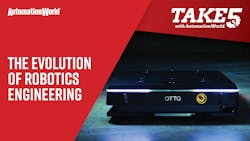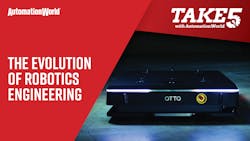Quick hits:
- Simulation software is a critical first-step for deploying fleets of autonomous mobile robots.
- 3D printing technologies have advanced enough to make production-ready parts on-demand.
- Innovative Industry 4.0 technologies mitigate the risk of big capital investments.
Welcome to Take Five, I’m Stephanie Neil, and I recently attended the Robotics Summit & Expo in Boston, which is really focused on the engineering techniques that will define the future of robots. Two of the trends that I quickly picked up on for manufacturing had to do with simulation and 3D printing.
Otto Motors is a maker of autonomous mobile robots, referred to as AMRs. These robots are highly collaborative and are designed to bring materials to and from people, equipment, and racks in a free-moving manner. But figuring out how to deploy them can be tricky.
So much of this is often done on a spreadsheet. But if estimates are wrong—either too many or too few robots on the floor—then a company is either not getting the productivity they require, or they could be spending more than they should.
The company’s co-founder and CEO, Matthew Rendall, gave a presentation on the use of simulation as a critical first step for large fleet implementations. The reason is that you have the ability to be highly granular and cater to the details of the layout.
Rendall talked about two different customer deployments. One of which is a brand new facility that has 300 pickup and drop off locations with AMRs doing 5,000 deliveries per day. Because they were starting from scratch, Otto Motors was able to use physics and process simulation to fully emulate the environment.
From there they can conduct micro-tests to understand how AMRs are interacting with the environment and ultimately create an end-to-end process for the operation. In this case, Otto Motors was able to reduce the number of AMRs needed for the operation from 102 to 83, which aside from the savings on the fleet size, it also resulted in a much smarter design.
He also talked about a customer with an older facility, which must deal with an existing mix of forklifts and people. So, while the approach to simulation is similar, the emphasis is more on how to phase in the robots without disrupting the operation. Ultimately, it’s about being more productive and mitigating risk.
And, another technology, additive manufacturing, also known as 3D printing, can help manufacturers as well.
Computer and printer company HP was also at the Robotics Summit. Liz Stortstrom, an application engineer for the company presented on the benefits of 3D printing.
Rapid innovation, shorter time to market, less inventory, and more efficient supply chains are just some of the ways that additive manufacturing is transforming the industry.
Using HP’s Multi Jet Fusion printing process, spare parts like end of arm tooling, jigs and fixtures, and electrical housing, can be made—pretty much on-demand.
The 3D printing technology has evolved to the point of having longer lasting tools with equal or similar properties and weight reduction without compromising part strength.
In one example of a 3D printed pneumatic end effector built for an apple-labeling machine, the cost of part production was reduced by almost 70%. When made with CNC machining, it cost $90 per part, while an HP printed part cost about $29.00.
HP continues to innovate its 3D printing capabilities, such as introducing flexible materials that could be used with collaborative robots. You can learn more about robot innovations in the links provided. That’s all we have time for today. Thanks for joining me.
Leaders relevant to this content:





